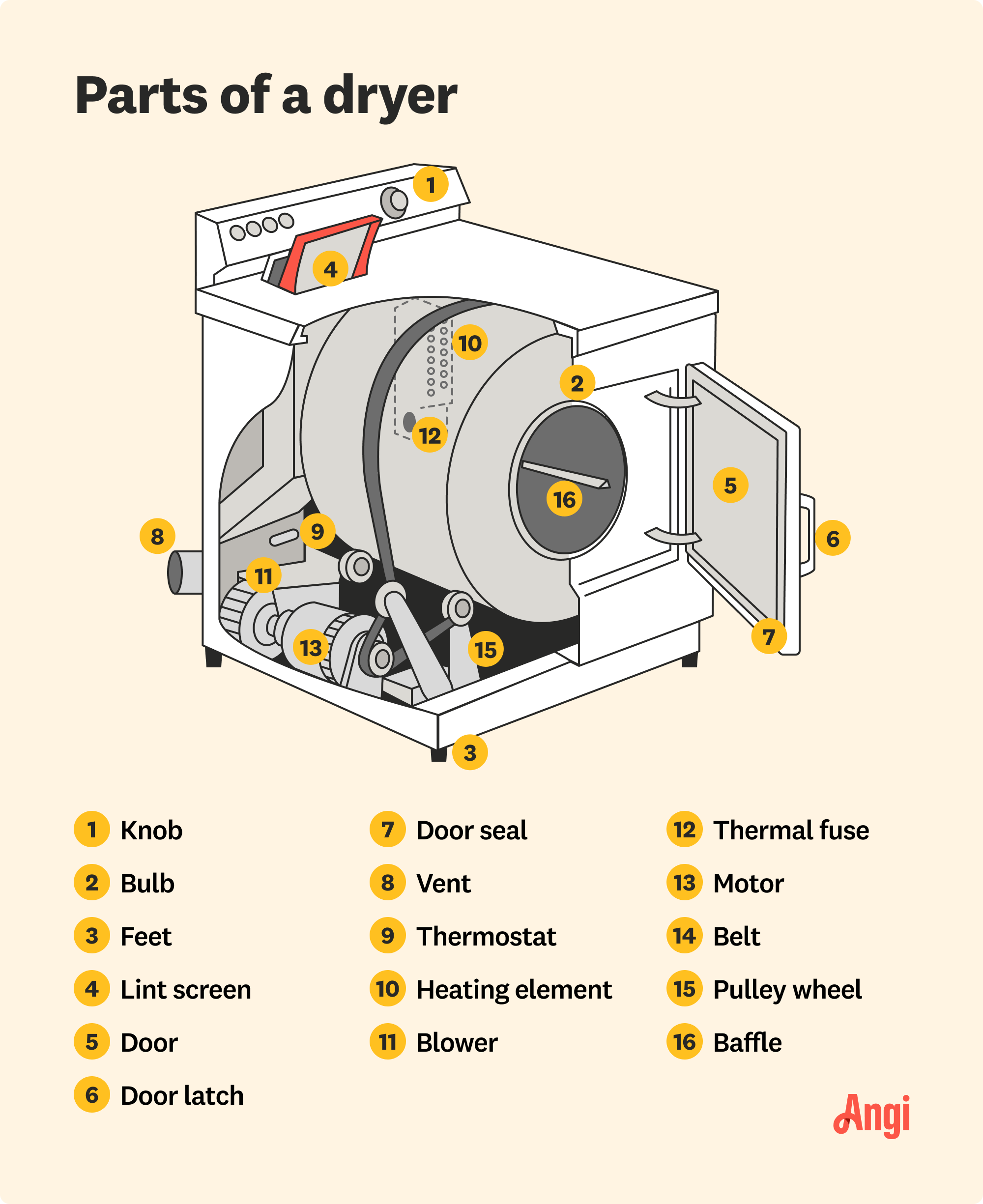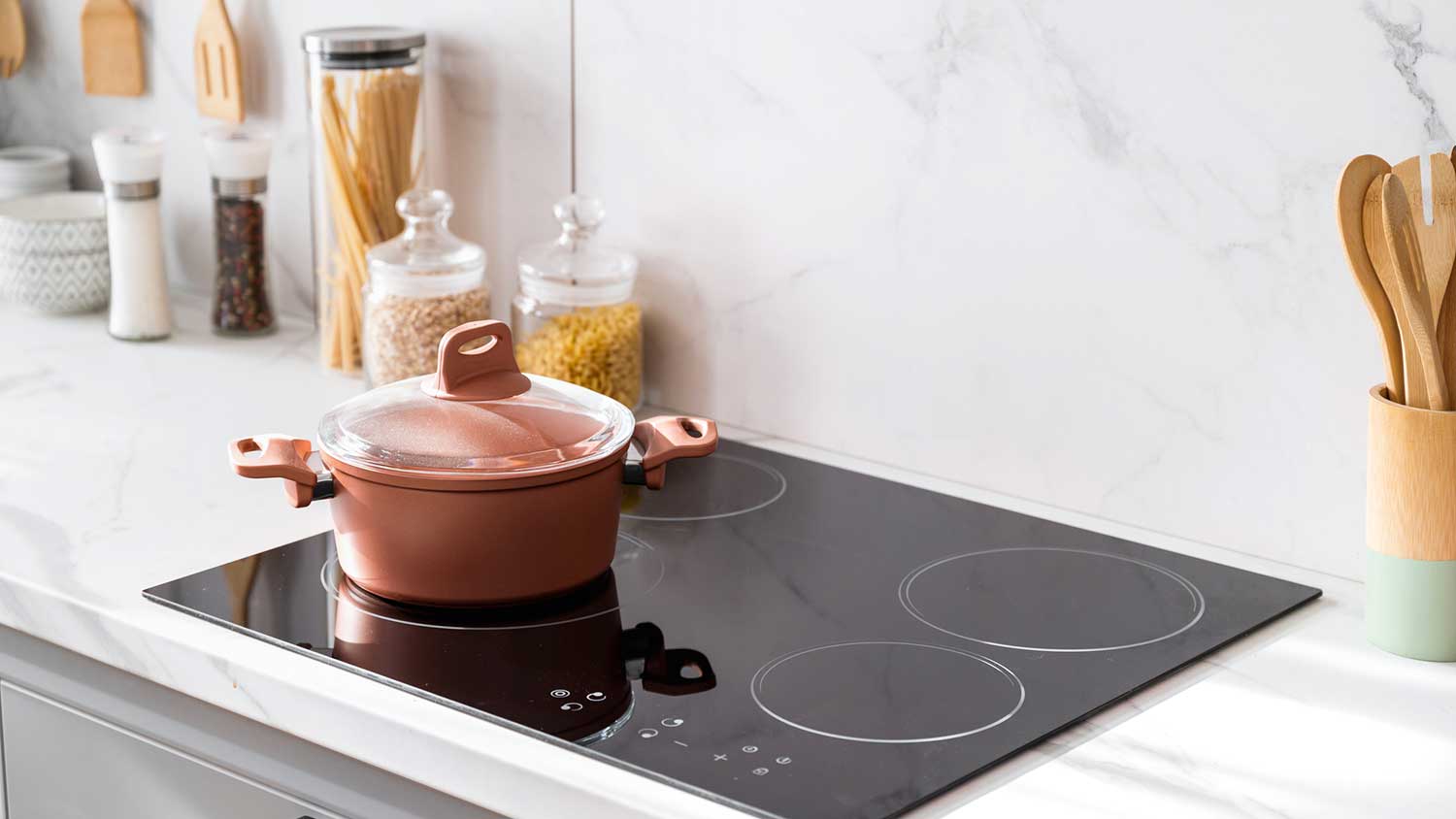
Depending on repair needs and machine age and type, the cost to replace a heating element in a dryer can vary. Learn the average repair costs.
Damp clothes got you down? Here are the parts to know


You can replace some dryer parts at a low cost, like the door gasket or pulley wheel.
The heating element and blower work together to ensure hot air circulates in the drum.
A pulley system powered by a motor rotates the drum during cycles.
The circuit board, motor, and heating element are the most expensive parts to replace.
Clean your lint filter after each cycle to prevent dryer malfunctions.
Your clothes dryer uses heat, airflow, and motion to dry and fluff your clothes, leaving them warm and smelling great. The key parts of a dryer include the heating element, drum, motor, and blower. Learn about more parts of a dryer and when to call a pro for help if something breaks down.

Each part of a dryer works together to remove moisture from your clothes and leave them dry. By knowing and maintaining the parts, you help improve your dryer’s performance, energy efficiency, and life span. Use the parts of a dryer diagram above to locate the different parts, but keep in mind that exact locations depend on your model and if it’s a top- or front-loading machine.
The external parts of a dryer are critical to its function and your ability to control the dryer settings.
The control panel has buttons, knobs, dials, and displays for cycle settings and cycle lengths. The control panel may also have lights or sounds that alert you to the end of a drying cycle or remind you to clean the lint filter. (We won’t tell anyone if you do a little dance to the dryer song.)
The dryer feet are secured to the bottom of the appliance and can be adjusted to move the dryer up or down. The feet are essential to holding the dryer in place and ensuring its level. An off-balance dryer will vibrate during the cycle and cause wear and tear on your machine.
Depending on the model, the lint filter is located on the exterior of the dryer or inside the door opening. It collects debris and lint to prevent clogged ducts and vents. You should empty the lint filter after each cycle.
The door gasket provides an airtight seal, preventing hot air from exiting the drum during the cycle. Without the gasket or seal, the dryer wouldn’t be able to maintain the proper temperature.
The dryer door latch ensures the door is shut and locked during the drying cycle. A broken latch prevents the door from closing and stops the cycle from running.
The door switch is a metal or hard plastic tab inside the door that operates as an on/off mechanism to prevent the dryer from working if the door is open. The switch might be stuck or broken if the dryer doesn’t start even when you close the door.
The baffles are the fins inside the drum that help tumble the laundry and enhance air circulation. You may need to tighten a loose baffle or replace one if it’s broken or comes off.
There are two main parts of a dryer vent: the tube made of strong, flexible material and the slated opening that allows hot, damp air to exit to the outside. The tubing connects to the back of the dryer. You should clean the vent and ductwork once a year to ensure there is no lint and debris clogging everything up.
A blocked or dirty dryer vent can pose a fire hazard to your home. When lint accumulates in the vent, the heat from your dryer could cause the lint to combust, triggering a spark that can start a fire. That’s why having your dryer vent professionally cleaned every year is so important.
The internal parts of a dryer create the heat, motion, and airflow that’s necessary for the dryer to remove moisture from your clothes.
The heating element is a coil or wire located in the back panel that runs on electricity, propane, or natural gas. The heating element heats the air that’s then circulated by the blower. If the dryer is not drying, the heating element could be the culprit. As one of the pricier parts of a dryer, the heating element costs an average of $230 to replace.
The thermostat controls and regulates the temperature inside the dryer, often between 120 and 160 degrees Fahrenheit. The high-limit thermostat ensures the dryer does not overheat.
The circuit board is located in the back panel and controls the dryer parts, including the timer, motor, and blower. The circuit board is essential to running the dryer and is one of the more costly items to replace should it malfunction.
The drum is the cylindrical container that holds the clothes inside the dryer. The drum is often made of stainless steel or coated metal to withstand high temperatures and the heavy weight of damp clothes.
The drum rollers are small wheels located near the drum. The rollers support and steady the drum while it spins during a cycle. If the drum rollers wear out, you may hear a loud rumbling noise. Replace the rollers to prevent damage to your machine.
The idler pulley wheel creates tension for the drive belt to rotate the drum during a cycle. The pulley wheel is in the back panel and makes a rattling or squealing noise when it needs replacement.
The drive belt wraps around the drum and connects the motor to the pulley system to rotate the drum. A broken drive belt means the drum can’t spin, so the clothes won’t dry. If the dryer turns on, but the drum isn’t rotating, you may need to replace the belt.
The motor powers the pulley system that rotates the drum during the drying cycle. The motor controls the speed and power of the rotation based on the cycle settings. The motor might need repair if the dryer doesn’t turn on, makes loud noises, or stops mid-cycle. The motor is located in the back of the dryer.
The blower is a type of fan that circulates hot air throughout the drum to remove moisture from the wet laundry. The blower is located near the motor at the lower back of the dryer.
If you're wondering why your dryer is squeaking, it could be the blower. The blower produces a high-pitched squeal when it starts to malfunction. You may also notice that loads take longer to dry.
The thermal fuse is a small but essential safety element that keeps your dryer from getting too hot. If the fuse detects the machine is overheating, it will blow, shutting off the dryer. If your dryer won’t start, it may be a fuse issue. You won't be able to turn the dryer back on again until you resolve the root cause of the overheating and replace the thermal fuse.
The sensors detect conditions like moisture levels in the drum during a drying cycle. This helps them indicate when the cycle is complete, signaling the appliance to stop running, which ensures optimal dryer performance. If the dryer is not drying, the moisture sensor strip may need replacement or cleaning.
The light bulb inside the dryer drum illuminates the interior so that you can see the clothes inside. While the light isn’t essential to the function of the dryer, you can replace it easily.

Gas and electric dryers provide comparable performance, convenience, and energy efficiency. In electric dryers, an electric current runs through metal coils to generate heat.
In gas dryers, the pilot light ignites the natural or propane gas to create heat. Metal plates transfer the heat into the drum of the dryer. Electricity powers the other components of a gas dryer, such as the control panel and light inside the drum. You’ll need a gas hookup in your laundry room for a gas dryer.
You can replace a door gasket, clean the lint filter, and level a dryer yourself. You can also replace certain parts, like the drive belt or a baffle, if you’re moderately handy.
Replacing the circuit board, heating element, and other complex parts is trickier. Contact a dryer repair pro near you to fix electrical issues or parts you’re unfamiliar with. Tinkering with appliances without expertise can create more expensive problems. The cost to repair a dryer ranges from $100 to $430, depending on the severity of the issue, your model, and the malfunctioning part.
From average costs to expert advice, get all the answers you need to get your job done.

Depending on repair needs and machine age and type, the cost to replace a heating element in a dryer can vary. Learn the average repair costs.

Several factors impact dryer vent installation cost. Use this guide to learn what affects the cost, and how much you should budget for this project.

Discover the average cooktop installation cost, key price factors, and tips to save. Learn what impacts your total cost and how to budget for your new cooktop.

After buying a new vented dryer, you may be wondering how to install it. Follow our step-by-step guide on how to install a dryer vent.

Learning how to determine washer box height in your laundry room will come in handy when you need to access your washer connections.

Let precision in the kitchen protect you from water contamination. Follow these simple steps for installing a dishwasher air gap.